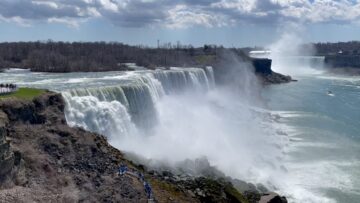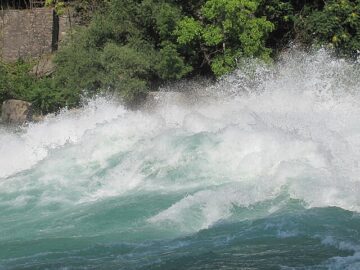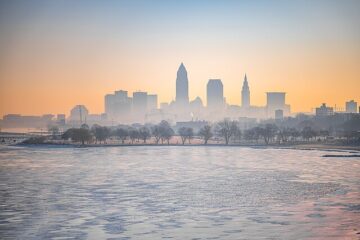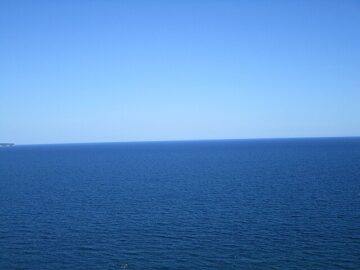by Steve Szilagyi

My favorite place on Earth is Niagara Falls. I refresh my spirit there. Standing on the very brink, my chest pummeled by the roar of millions of gallons of fresh water plunging into the abyss, I feel at one with figures like Margaret Fuller, Charles Dickens, and Mark Twain, each of whom recorded their humbled awe at the spectacle. I throw my mind into the past and imagine countless generations of Native Americans standing on the brink of the Falls and wondering, as many do today: where is all this water going?
Well, I’ll tell you where it goes: down the Niagara Gorge, into Lake Ontario, into the St. Lawrence Seaway, and finally to the Atlantic Ocean, where it mixes with the saltwater and is, for all practical purposes, wasted.
Now I’ll tell you where it isn’t going: it isn’t going to the showerhead in my luxury Niagara Falls hotel room. Even though I can look through my window and see 44,500 gallons of fresh water tumbling over the brink every minute, when I step into my marbled bathroom and turn on the shower, I stand under the same strangled trickle I’d get in a cheap motel outside Salinas, California, or another city with severe water use restrictions.
Primal pleasure denied. I don’t need to sell anyone on the satisfaction of a good, strong shower—hot, but not too hot, slightly stinging, and thoroughly cleansing of both body and soul. Yet this primal pleasure has not been widely available since 1992, when the U.S. Energy Policy Act mandated that new showerheads sold in the country not exceed 2.5 gallons per minute.
The Energy Policy Act makes sense for places like the American West, where the combination of climate change, cattle farming, and almond growing has created a dire water situation. But Niagara Falls?
Let me refresh your memory: Niagara Falls is a constituent feature of the Great Lakes Basin, which holds 6 quadrillion gallons of fresh water—or 84 percent of the fresh surface water in the continental United States. Lakes Superior, Michigan, Huron, Erie, and Ontario are continually replenished by the region’s abundant rainfall and the 35,000 rivers and streams that flow into them. All this water eventually goes over Niagara Falls. The trillions of gallons not captured by agriculture, industry, evaporation, or household use flow past Montreal on their way to the Atlantic—and oblivion.

Climate change considerations. Few, if any, climate change models predict that the Great Lakes will lose water over the next 500 years. Some even foresee the Great Lakes gaining water due to increased precipitation.
And let me tell you, folks, if you’ve never stood on the shore of a Great Lake, you don’t know just how huge they are. You can’t see the other side. Even the smallest of them, Lake Erie, might as well be the Pacific Ocean if you’re standing on the shore looking out.
But unlike the Pacific Ocean, every drop of Lake Erie water is economically available, usable, and infinitely recyclable—thanks to the region’s outstanding water treatment plants and runoff management systems.
Drink deeply. So while it makes sense for Los Angelenos to ration water like shipwreck survivors in a lifeboat, there’s no reason why the residents of Buffalo, New York, shouldn’t drink deeply from the treasure that surrounds them and shower heartily under its spray. Yes, we should all be mindful of natural resource use, but there comes a point where mindfulness gives way to martyrdom. That point, I believe, is somewhere under a low-flow shower in the vicinity of Niagara Falls.
And how about this: according to Claude and ChatGPT, if all 40–50 million people currently living in the Great Lakes Basin were to run their showers and flush their toilets continuously for 100 years, it would have no discernible impact on the water levels of the Great Lakes. In fact, say the AI savants, we could more than double the current water drawdown from the Great Lakes and not, so to speak, dent the surface.
I am aware that, on the scale of world crises, the shower preferences of spoiled Americans might seem like the most trivial of first-world problems. But punitive, one-size-fits-all laws like the shower-strangling Energy Policy Act encourage disrespect for environmental regulations that actually do good. Besides, how is something like showering—something most Americans do once or even twice daily—trivial? And what, after all, is the content of any human life but the continual pursuit of small, ephemeral gratifications—like a piece of candy or a good shower?

Dramatic population loss. With all the fresh water in the Great Lakes Basin, you’d think the population here would be booming. But as we know, cities in the region have been emptying out for years. Cleveland, for instance, has lost about half its population since its major league baseball team last won the World Series in 1948. Many, if not most, of those who’ve left have moved to Sun Belt states. These states, even without climate change, would soon be facing excruciating water shortages. (Seven states, constituting 20 percent of the continental U.S. landmass, rely on one river—the Colorado—for their water.)
But what the western states lack in water, they make up for in brainpower. Brilliant thinkers like polymath Casey Handmer, CEO of California’s Terraform Industries, have come up with bold plans to reshape the landscape of the entire American West for optimized water use. Handmer’s proposal (detailed in his Casey Handmer’s Blog) involves solar-powered desalination plants, pumping water uphill, and transforming Nevada into a land of lakes, like Minnesota.
This, however, seems like a lot of trouble. Why don’t the western states simply run a pipeline from Lake Superior to Los Angeles and get all the fresh water they need? It’s a fiendish idea—and more than one Dr. Evil-type entrepreneur has plotted it. Fortunately, the water riches of the Great Lakes region are protected by the Great Lakes Compact—a kind of Justice League of states and provinces formed to thwart any designs to divert Great Lakes water elsewhere.
The members of the Great Lakes Compact include Illinois, Indiana, Michigan, Minnesota, New York, Ohio, Pennsylvania, and Wisconsin, with Ontario and Quebec aligned through a similar pact called the Great Lakes-St. Lawrence River Basin Sustainable Water Resources Agreement.
(In one of my fantasy worlds, the member states and provinces of these two conclaves assemble their own armed forces, secede from their respective nations, and create a new world power: Showerlandia. We would be the Saudi Arabia of fresh water, dictating terms to the rest of the world. This wouldn’t be so bad, since as Midwesterners and Canadians, we’d also be the Saudi Arabia of “nice.”)
No need to build it, it’s already here. Yes, the Great Lakes Compact prevents westerners from coming here and siphoning off our water. But it doesn’t stop westerners from moving their businesses, industries, and homes to the region and using as much water as they need (unless they plan to shower).
In other words, you don’t need to terraform the entire West to get abundant fresh water. You only need to move to Cleveland.
Few people in places like Los Angeles, Denver, and Phoenix are eager to move to Cleveland, Detroit, Buffalo, or Toledo. But those of us who live in these places are pretty sure that they’ll eventually come. In fact, the migration has already begun in small ways. A few hardy pioneers from the West have made their way here, drawn by good schools, reasonable temperatures, and the ability to buy something in Shaker Heights akin to the Chicago mansion in Home Alone for the price of a two-bedroom condo in San Bernardino. But it’s not happening fast enough.

All but the most meanest Great Lakes cities are magnificently situated on the water. Toledo, Sandusky, Erie, and Buffalo, in particular, have uniquely beautiful settings. If you walk through the nearly deserted downtowns of Detroit, Buffalo, Cleveland, or Toledo, you’ll see skyscrapers, train stations, government buildings, streets, squares, plazas, and rapid transit systems built to accommodate two to three times the population they currently serve.
Go a little further out, and you’ll find broad university campuses, acres of parkland, beaches, concert halls, symphony orchestras, and art museums—not to mention many of the nation’s top hospitals and academic medical centers. It’s a regional infrastructure as fine as any in the world. But it won’t last. Nothing abandoned does. Parts of these cities are slowly crumbling, both physically and culturally. Gary, Indiana, and East Cleveland, Ohio, are returning to a feral state, with their magnificent homes and empty factories slowly reverting to woodland. The wealthy patrons who support orchestras, museums, colleges, and universities are aging and passing on. But there’s still plenty of the old splendor left—especially in the realm of water supply.
The relentless pace of climate change almost guarantees we will see a renaissance of Great Lakes towns and cities. My hope is that this new golden age begins sooner rather than later—that is to say, before I have to sell my house. With so many westerners probably willing to die rather than move to some “square” Great Lakes city full of nice people and great houses, we clearly need a stronger incentive than the prospect of the entire southwestern United States turning into Death Valley. We need something so attractive, so powerfully appealing to all human beings—young and old, rich and poor—that it would trigger a stampede of wealth, intelligence, and innovation into the region. And I know what that incentive should be: high-flow showers.
The Great Lakes Compact should collect all the low-flow showerheads they can get their hands on, create a great pyramid of the miserable things in some public place, and then have them melted down and recast as high-power showerheads, to be distributed to every household in the region. Then, the Compact should declare a permanent high-flow holiday, encouraging the entire population to rip off their clothes, turn the water up high, and settle in for a nice, long shower.
Not everyone in the West would move here. But enough might leave to reduce water demand in the West to more manageable levels. This would also ensure the drastically underutilized urban infrastructure of the Great Lakes Basin is running at full capacity and contributing its share to the national stock of innovation, progress, and prosperity.
And once we’ve accomplished these things, and residents and visitors to Niagara Falls can enjoy high-flow showers, we can finally turn our attention to switching out our low-flow toilets, dishwashers, and washing machines.

Enjoying the content on 3QD? Help keep us going by donating now.
